Bengal bamboo, Spineless Indian bamboo
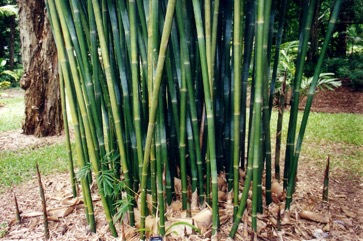
A tropical and subtropical plant. It grows in Nepal at 200-1200 m altitude. It grows in moist soils near rivers. It grows up to 1500 m altitude in Bangladesh. In the Cairns Botanical Gardens. In Yunnan.
Also known as:
Auwa gubwi, Ba, Bakal, Bambu india, Banse, Bas, Bijuli, Bong, Calcutta cane, Chat-wa, Chekeme, Deo-bans, Deobans, Dibang, Ghora, Govatuai, Govatuoi, Jati bah, Jao, Jowa, Karil, Kharra, Kiranti, Liangpai, Mai bong, Mak, Matela, Mirtinga, Nal-bans, Peka, Phai hangchang, Phai-bongdam, Rawthing, Utang, Talagu-wa, Taru bans, Thaik-wa, Tre xim, Tulda, Tusa, Wagi, Wamuna, Wandal, Wati
Synonyms
- Dendrocalamus tulda (Roxb.) Voigt.
- Bambusa longispiculata Gamble ex Brandis
Edible Portion
- Shoots, Rhizomes, Root, Seeds
Where does Bengal bamboo grow?
Found in: Asia, Australia, Bangladesh, Bhutan, China, Himalayas, India - Assam, Indochina, Indonesia, Laos, Myanmar, Nepal, Northeastern India, Pacific, Philippines, SE Asia, Thailand, United States, Vietnam
Notes: There are about 120 Bambusa species. They are tropical and subtropical in Asia.
Status: It is important in northern Thailand for edible shoots. It is common in Bangladesh. It is in high demand as bamboo shoots. It is sold in local markets. It is cultivated.
Growing Bengal bamboo, Spineless Indian bamboo
Cultivation: They can be grown from branch or culm cuttings. They can also be grown from seed. Seeds only remain viable for about one month unless dried. Seeds germinate in about 8 weeks. Seeds after germination produce a stem in about one month. Seedlings can be ready to plant out in 18-20 weeks.
Edible Uses: The young shoots are boiled and eaten. The water is changed. They are also used in soup. They are also pickled. The harvested young shoots can be stored for 8-10 days. They are also dried for future use.
Production: A 1000 seeds weigh 70 g. Young shoots to be used as a vegetable should preferably be harvested while still underground.
Nutrition Info
per 100g edible portion| Edible Part | Energy (kcal) | Protein (g) | Iron (mg) | Vitamin A (ug) | Vitamin c (mg) | Zinc (mg) | % Water |
|---|---|---|---|---|---|---|---|
| Shoots | - | - | 3.2 | - | 1.4 | 0.7 |
Bengal bamboo, Spineless Indian bamboo Photos

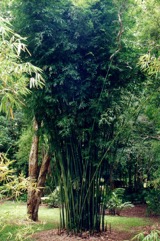
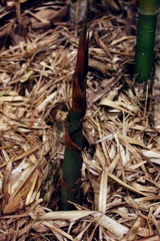
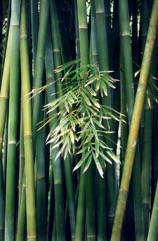
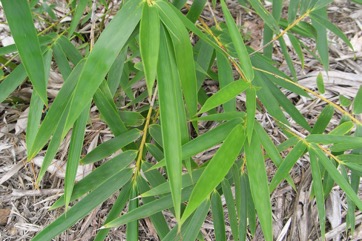
References
Ambasta S.P. (Ed.), 2000, The Useful Plants of India. CSIR India. p 67
Anderson, E. F., 1993, Plants and people of the Golden Triangle. Dioscorides Press. p 203
Angami, A., et al, 2006, Status and potential of wild edible plants of Arunachal Pradesh. Indian Journal of Traditional Knowledge 5(4) October 2006, pp 541-550
A Rapid Participatory Biodiversity Assessment. 2007, Southern Lao PDR. IUCN p 42
Arora, R. K., 2014, Diversity in Underutilized Plant Species - An Asia-Pacific Perspective. Bioversity International. p 36
Bandyopadhyay, S. et al, 2009, Wild edible plants of Koch Bihar district, West Bengal. Natural Products Radiance 8(1) 64-72
BARC, 2016, State of Biodiversity for Food and Agriculture in Bangladesh. Bangladesh Agricultural Research Council.
Baro, D., Baruah, S. and Borthukar, S. K. 2015, Documentation on wild vegetables of Baksa district, BTAD (Assam). Scholars Research Library. Archives of Applied Science Research, 2015, 7 (9):19-2
Bircher, A. G. & Bircher, W. H., 2000, Encyclopedia of Fruit Trees and Edible Flowering Plants in Egypt and the Subtropics. AUC Press. p 53
Bodkin, F., 1991, Encyclopedia Botanica. Cornstalk publishing, p 127
Chowdery, T., et al, 2014, Wild edible plants of Uttar Dinajpur District, West Bengal. Life Science Leaflets. 47:pp 20-36 http://lifesciencesleaflets.ning.com
Chowdhury, M. & Mukherjee, R., 2012, Wild Edible Plants Consumed by Local Communities of Maldah of West Bengal, India. Indian J.Sci.Res.3(2) : 163-170
Deb, D., et al, 2013, Wild Edible Plants and Their Utilization in Traditional Recipes of Tripura, Northeast India. Advances in Biological Research 7(5):203-211
Delang, C. O., 2007, Ecological Succession of Usable Plants in an Eleven-Year Fallow Cycle in North Lao P.D.R., Ethnobotany Research and Applications. Vol. 5:331-350
Dobriyal, M. J. R. & Dobriyal, R., 2014, Non Wood Forest Produce an Option for Ethnic Food and Nutritional Security in India. Int. J. of Usuf. Mngt. 15(1):17-37
Dransfield, S. & Widjaja, EA., 1995, Plant Resources of South East Asia. PROSEA No. 7 Bamboos. Leiden. p 69
Dutta, U., 2012, Wild Vegetables collected by the local communities from the Churang reserve of BTD, Assam. International Journal of Science and Advanced Technology. Vol. 2(4) p 119
Fl. ind. ed. 1832, 2:193. 1832
Gangte, H. E., et al, 2013, Wild Edible Plants used by the Zou Tribe in Manipur, India. International Journal of Scientific and Research Publications, Volume 3, Issue 5
Guite, C., 2016, A study of wild edible plants associated with the Paite tribe of Manipur, India, International Journal of Current Research. Vol. 8, Issue, 11, pp. 40927-40932
Hedrick, U.P., 1919, (Ed.), Sturtevant's edible plants of the world. p 90
Hibbert, M., 2002, The Aussie Plant Finder 2002, Florilegium. p 37
Joshi, N. & Siwakoti, M., 2012, Wild Vegetables Used by Local Community of Makawanpur District and Their Contribution to Food Security and Income Generation. Nepal Journal of Science and Technology Vol. 13, No. 1 (2012) 59-66
Kumari, P, 2019, Bambusoideae in India: An Updated Enumeration. Plantae Scientia : Volume 01, Issue 06, March 2019
Lalfakzuala, R., 2007, Ethnobotanical usages of plants in western Mizoram. Indian Journal of Traditional Knowledge. Vol 6(3) pp 480-493
Lim, T. K., 2015, Edible Medicinal and Non Medicinal Plants. Volume 9, Modified Stems, Roots, Bulbs. Springer p 15
Luczaj, L., et al, 2021, Wild food plants and fungi sold in the markets of Luang Prabang, Lao PDR. Journal of Ethnobiology and Ethnomedicine (2021) 17:6
Manandhar, N.P., 2002, Plants and People of Nepal. Timber Press. Portland, Oregon. p 104
Marandi, R. R. & Britto, S. J., 2015, Medicinal Properties of Edible Weeds of Crop Fields and Wild plants Eaten by Oraon Tribals of Latehar District, Jharkhand. International Journal of Life Science and Pharma Research. Vo. 5. (2) April 2015
Narzary, H., et al, 2013, Wild Edible Vegetables Consumed by Bodo tribe of Kokrajhar District (Assam), North-East India. Archives of Applied Science Research, 5(5): 182-190
Patiri, B. & Borah, A., 2007, Wild Edible Plants of Assam. Geethaki Publishers. p 161
Premlata, T., et al, 2020, Edible bamboo resources of Manipur: consumption pattern of young shoots, processing techniques and their commercial status in the local market. Indian Journal of Traditional Knowledge Vol. 19(1) pp 73-82
Ray, A., et al, 2020, How many Wild Edible Plants do we Use. Frontiers in Sustainable Food Systems. 4:56 p 12
Roy, A., et al, 2017, Insight into Bamboo-based Fermented Foods by Galo (Sub-tribe) of Arunachal Pradesh, India. Int. J. Life. Sci. Scienti. Res., 3(4): 1200-1207
Saikia, M., 2015, Wild edible vegetables consumed by Assamese people of Dhemaji District of Assam, NE India and their medicinal values. Archives of Applied Science Research, 2015, 7 (5):102-109
Sarma, H., et al, 2010, Updated Estimates of Wild Edible and Threatened Plants of Assam: A Meta-analysis. International Journal of Botany 6(4): 414-423
Singh, H.B., Arora R.K.,1978, Wild edible Plants of India. Indian Council of Agricultural Research, New Delhi. p18
Sukarya, D. G., (Ed.) 2013, 3,500 Plant Species of the Botanic Gardens of Indonesia. LIPI p 838
Teron, R. & Borthakur, S. K., 2016, Edible Medicines: An Exploration of Medicinal Plants in Dietary Practices of Karbi Tribal Population of Assam, Northeast India. In Mondal, N. & Sen, J.(Ed.) Nutrition and Health among tribal populations of India. p 154
Tutul, E et al, 2009, Angiospermic Flora of Runctia Sal Forest, Bangladesh. Bangladesh J. Plant Taxon. 16(1): 83-90. p 86
Upreti, T.C. and Sundriyal, R. C., 2001, Bamboo and cane resources of Arunachal Pradesh: Utilization pattern and implications for management. Bamboo Science and Culture: The Journal of the American Bamboo Society 15(1):20-34
USDA, ARS, National Genetic Resources Program. Germplasm Resources Information Network - (GRIN). [Online Database] National Germplasm Resources Laboratory, Beltsville, Maryland. Available: www.ars-grin.gov/cgi-bin/npgs/html/econ.pl (10 April 2000)
Waikhom, S. D., et al, 2013, Grappling the High Altitude for Safe Edible Bamboo Shoots with Rich Nutritional Attributes and Escaping Cyanogenic Toxicity. BioMed Reserch International. Voluyme 2013 Article ID 289285, 11 pages
Waikhom, S. D. and Louis, B., 2014, An Effective Protocol for Micropropagation of Edible Bamboo Species (Bambusa tulda and Melocanna baccifera) through Nodal Culture. The Scientific World Journal Volume 2014, Article ID 345794, 8 pages
Wild edible plants of Himachal Pradesh
World Checklist of Useful Plant Species 2020. Royal Botanic Gardens, Kew